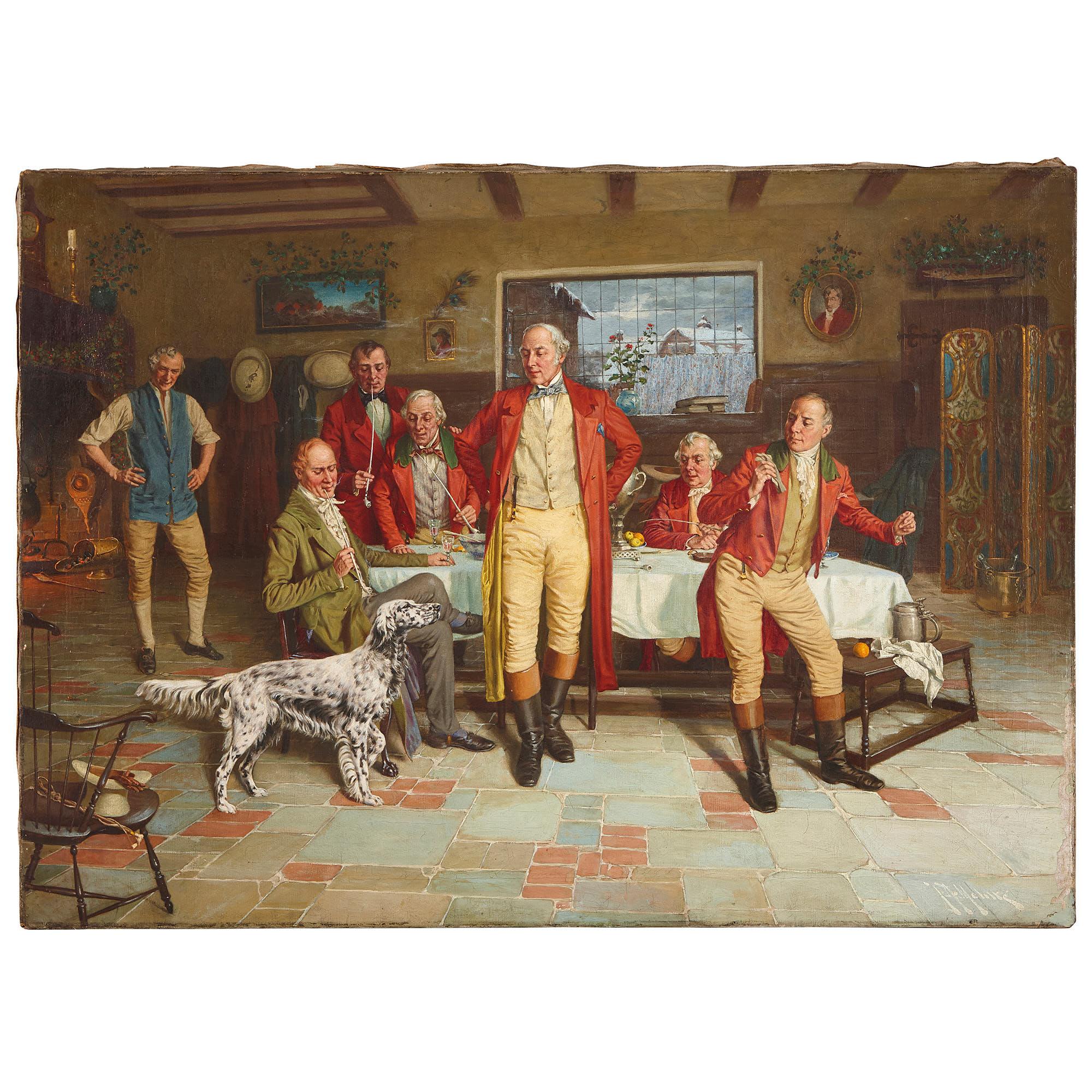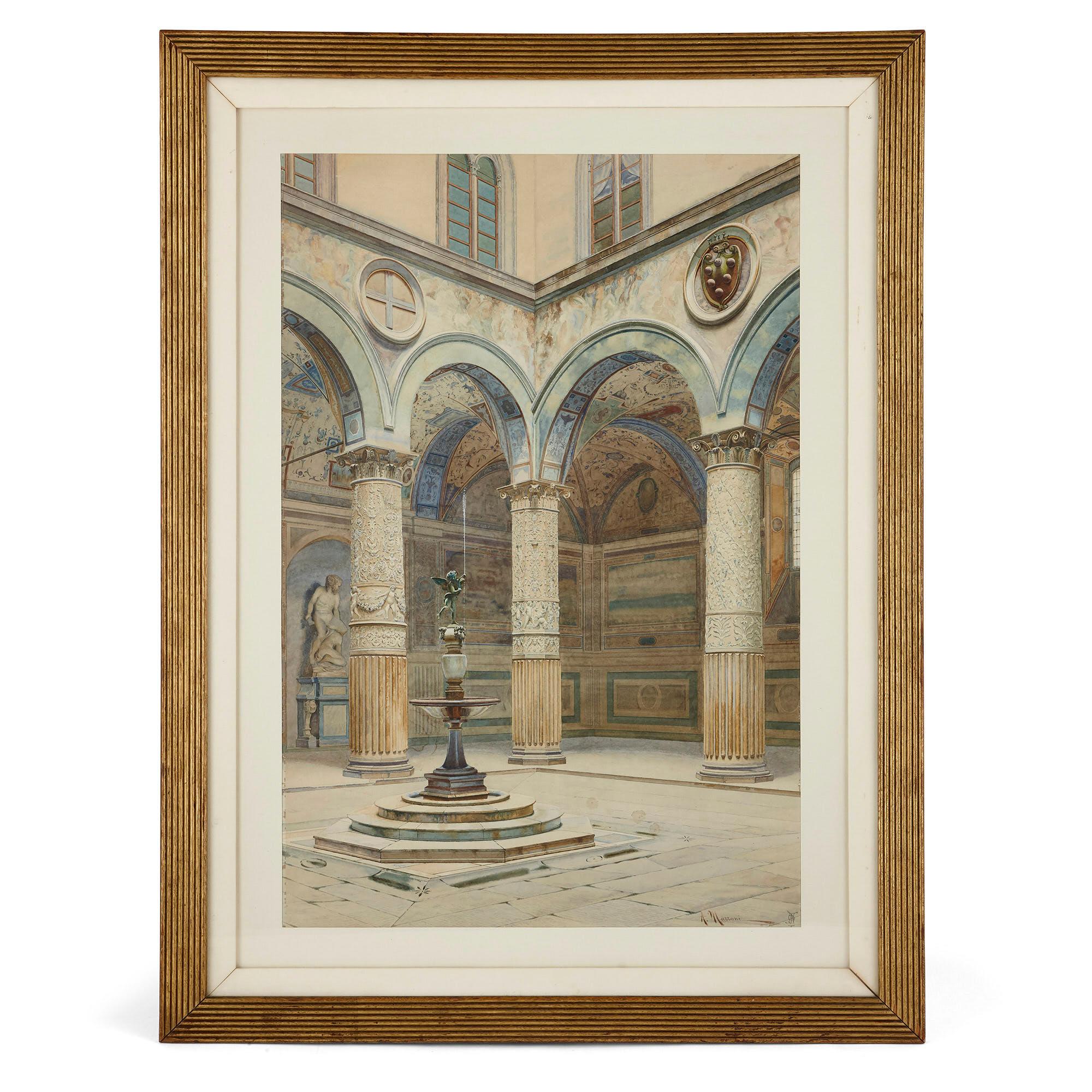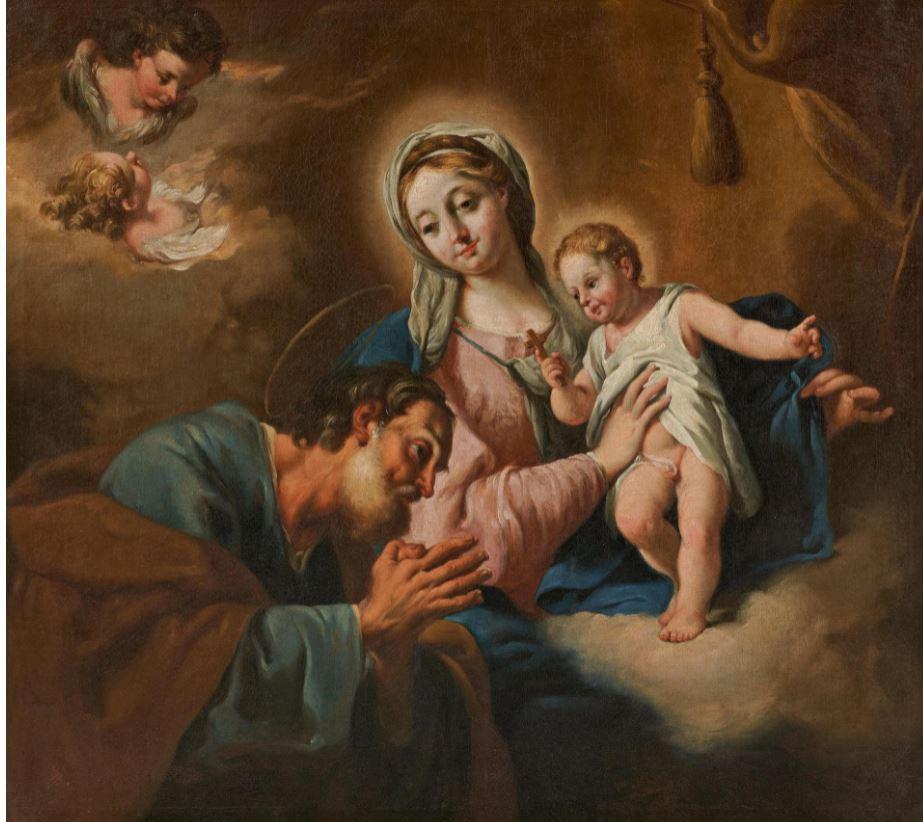Items Similar to Alfred Broge, Courtyard With Thatched Cottage & Seated Woman, Oil Painting
Want more images or videos?
Request additional images or videos from the seller
1 of 13
Alfred BrogeAlfred Broge, Courtyard With Thatched Cottage & Seated Woman, Oil Painting1924
1924
About the Item
This early 20th-century oil painting by Danish artist Alfred Broge (1870-1955) depicts a rustic courtyard with thatched cottage and seated woman.
Amidst the gritty and grimy changes of ever-advancing industrialisation, Broge’s works offered a sunlit glimpse at a more idyllic, sentimental time. One in which handicrafts were passed through the generations and simple rural lifestyles were cherished. These rose-tinted visions were popular among the Danish bourgeoisie who sought to celebrate the rich rural heritage of their homeland and decorate their walls with appropriate images. And as such, his paintings were often reproduced as postcards and prints to meet this demand.
His popularity and traditional style led to a successful 40-year career, during which he exhibited regularly at Charlottenborg Palace. He was also shown at numerous independent exhibitions across Denmark.
Signed/dated lower left and held within a coved gilt exhibition frame, which is probably original.
Labels & Inscriptions: Label from art dealer Georg Kleis on reverse together with stock number.
Provenance: With Georg Kleis, art dealer, Copenhagen / Private collection, Denmark.
Artist’s auction maximum: £10,375
- Creator:Alfred Broge (1870 - 1955, Danish)
- Creation Year:1924
- Dimensions:Height: 27.5 in (69.85 cm)Width: 28 in (71.12 cm)
- Medium:
- Movement & Style:
- Period:
- Condition:Assessed and approved by our conservator. Frame with light marks and signs of age.
- Gallery Location:Cheltenham, GB
- Reference Number:1stDibs: LU2328214249272
About the Seller
5.0
Platinum Seller
These expertly vetted sellers are 1stDibs' most experienced sellers and are rated highest by our customers.
Established in 2017
1stDibs seller since 2023
132 sales on 1stDibs
Typical response time: 1 hour
- ShippingRetrieving quote...Ships From: Cheltenham, United Kingdom
- Return PolicyA return for this item may be initiated within 14 days of delivery.
More From This SellerView All
- Karl Feiertag, Lacemakers At Burano, Venice, Antique Oil PaintingLocated in Cheltenham, GBThis early 20th-century oil painting by Austrian artist Karl Feiertag (1874-1944) depicts two young women making lace in Burano, Venice. Sat within a qu...Category
Early 1900s Figurative Paintings
MaterialsOil, Canvas
- Sophus Vermehren, Her Favourite Story, Oil PaintingLocated in Cheltenham, GBThis mid-20th-century oil painting by Danish artist Sophus Vermehren (1866-1950) depicts a grandmother reading to her granddaughter, who is convalesci...Category
1940s Interior Paintings
MaterialsCanvas, Oil
- Knud Sinding, Kitchen Interior With Mother & Child, Oil PaintingLocated in Cheltenham, GBThis charming early-20th-century oil painting by Danish artist Knud Sinding (1898-1947) depicts a kitchen interior with mother and child. A gentle br...Category
1910s Impressionist Interior Paintings
MaterialsCanvas, Oil
- Charles Rossiter, Very IndustriousLocated in Cheltenham, GBThis charming mid-19th-century oil painting by British artist Charles Rossiter (1827-1897) depicts a girl sewing before a window with a view through to a garden. It was shown at The ...Category
1870s English School Figurative Paintings
MaterialsOil, Canvas
- Théophile Emmanuel Duverger, BackstageBy Théophile Emmanuel DuvergerLocated in Cheltenham, GBThis charming mid-19th-century oil painting by French artist Théophile Emmanuel Duverger (1821-1886) depicts a young woman preparing a chil...Category
1870s French School Figurative Paintings
MaterialsCanvas, Oil
- Robert Thorburn Ross RSA, Carding, Oil PaintingLocated in Cheltenham, GBThis mid-19th-century oil painting by Scottish artist Robert Thorburn Ross RSA (1816-1876) depicts a seated woman carding wool within a rustic interior. Robert Thorburn Ross RSA was...Category
1850s Victorian Interior Paintings
MaterialsOil, Canvas
You May Also Like
- Group portrait painting after the hunt, oil on canvasLocated in London, GBThis charming painting depicts a group of gentlemen gathered around a kitchen table and admiring an English Setter. The snowy rooftops, just visible from the kitchen window, combined with the lit fire and holly decorating the picture frames in the room, implies that this is a Christmas scene. It also appears that the gentlemen have just returned from a fox hunt, and are now warming themselves, drinking port and smoking long pipes by the fire. Five men — three gathered behind the table and two standing in front — are identically dressed in long black riding boots...Category
Early 20th Century Naturalistic Figurative Paintings
MaterialsOil, Canvas
- 'Spinning the Wool', 19th Century Flemish oil painting of two ladiesBy Edward Antoon PortieljeLocated in London, GBThis fine antique oil painting depicts two ladies seated in a 19th Century style interior. In front of the woman on the right is an antique wool spinner; the woman pauses her work at...Category
19th Century Naturalistic Interior Paintings
MaterialsCanvas, Oil
- The Lute Player - A Flemish Interior after David Teniers II - 18thC Oil PaintingBy David Teniers the YoungerLocated in Meinisberg, CHThe Lute Player, the Flute Player and Singers making Music • 18thC Oil on iron sheet, ca. 32 x 26.5 cm • Later Frame, ca. 40 x 34 cm Here we have a...Category
Late 18th Century Naturalistic Figurative Paintings
MaterialsIron
- Antique watercolour of Palazzo Signoria in FlorenceBy A. MarraniLocated in London, GBThis beautiful view of a Florentine courtyard was painted by A. Marrani, an artist who, in the late 19th Century, painted many views of the Tuscan city. The cortile (‘courtyard’) sho...Category
Late 19th Century Naturalistic Figurative Paintings
MaterialsPaper, Watercolor, Board
- Giovanni Battista Pittoni, Holy Family with Cupids, Venetian Baroque, ChristmasBy Giovanni Battista PittoniLocated in Greven, DEIn 2001 the German art historian Art historian and Raphael Expert, Prof. Jürg Meyer zur Capellen, published the painting "Die Heilige Familie" in a monographic article, ascribing the present work to the Venetian painter Giovanni Battista Pittoni (1687 -Venice - 1767). (Newspaper "Weltkunst", October 2001, No 12, p. 1850 f. ill.) He describes it as a typical work by this artist. Pittoni was one of the most influential and successful artists of the Venetian Settecento. He was a pupil of the Veronese Master Giovanni Balestra (1666-1740). His style is influenced by Sebastiano Ricci (1659-1734) and Giambattista Tiepolo (1696-1770). Giovanni Battista Pittoni was already successful at a young age and soon lead his own workshop. He created large-scale hitoria paintings, as well as large, religious altarpieces. In addition to Venetian and Upper Italian patrons, Pittoni also had many interested parties from Europe. His work is accordingly scattered in many different museums and private collections today. Pittoni - like other painter colleagues of his time - repeated his own compositions both by hand and with the help of his workshop. He repeatedly incorporated details into other pictures and contexts. Prof. Meyer zur Capellen noted the very good condition of the present work and the high quality of the paint with fine graduations and the vivid brushstrokes. Provenance: The panting has not been on the art market for at least 300 years. In the year 2000 the work was donated by the Münster-based, Noble Family Ketteler zu Harkotten to a private collection in Westphalia. Most probably the canon Nikolaus Hermann von Ketteler zu Harkotten bought the piece in Venice in 1750 together with the altarpiece of the Clemens Church in Münster. On the reverse of the work is a fideicommissum number by Ketteler zu Harkotten. As it belonged to the family commission, the painting was inalienable until 1919, when the corresponding law was repealed, and after that time it remained in the family's possession without interruption. Pittoni's only direct relationship to Münster is the commission for the high altar painting of the Baroque St. Clemens Church. It can be assumed that then canon von Ketteler saw this painting in the artist's workshop during his stay in Venice and acquired it for himself. This would also explain the discrepancy in dating. (ca. 1735/1750). However, it is also possible that the painting originated in the possession of Ferdinand von Plettenberg...Category
Early 18th Century Rococo Figurative Paintings
MaterialsCanvas, Oil
- Early 20th century French oil, seated ballerina adjusting her ballet slipper.Located in Woodbury, CTVery Impressive French Impressionist figure study of a Ballerina seated in an interior. A very decorative and very desirable oil on canvas dating from the early 1900's The painting...Category
Early 1900s Impressionist Figurative Paintings
MaterialsCanvas, Oil
Recently Viewed
View AllMore Ways To Browse
Antique Interior
Antique Style Interior
Danish Interior
Interior Vision
Antique Woman Painting
Palace Interior
Antique Estate Painting
Danish Palace
Auction Oil Paintings
Oil Paintings At Auction
Vision Antique
Cottage Painting
Antique Oil Painting Woman
Antique Art Auction
Art Antique Auction
Antique Oil Painting Of Woman
Painting Of Cottages
Antique Oil Painting Of A Woman




